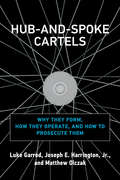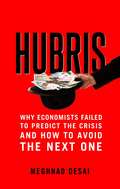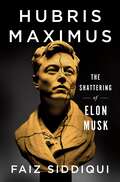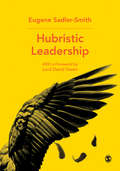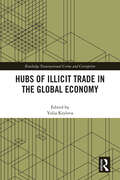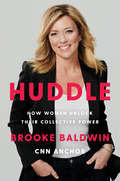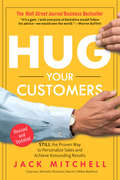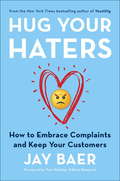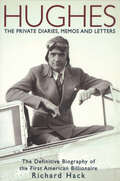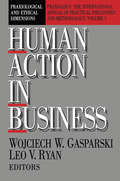- Table View
- List View
Hub-and-Spoke Cartels: Why They Form, How They Operate, and How to Prosecute Them
by Joseph E. Harrington Luke Garrod Matthew OlczakThe first comprehensive economic and legal analysis of hub-and-spoke cartels, with detailed case studies.A cartel forms when competitors conspire to limit competition through coordinated actions. Most cartels are composed exclusively of firms that would otherwise be in competition, but in a hub-and-spoke cartel, those competitors (&“spokes&”) conspire with the assistance of an upstream supplier or a downstream buyer (&“hub&”). This book provides the first comprehensive economic and legal analysis of hub-and-spoke cartels, explaining their formation and how they operate to create and sustain a collusive environment. Sixteen detailed case studies, including cases brought against toy manufacturer Hasbro and the Apple ebook case, illustrate the economic framework and legal strategies discussed. The authors identify three types of hub-and-spoke cartels: when an upstream firm facilitates downstream firms to coordinate on higher prices; when a downstream intermediary facilitates upstream suppliers to coordinate on higher prices; and when a downstream firm facilitates upstream suppliers to exclude a downstream rival. They devote a chapter to each type, discussing the formation, coordination, enforcement, efficacy, and prosecution of these cartels, and consider general lessons that can be drawn from the case studies. Finally, they present strategies for prosecuting hub-and-spoke collusion. The book is written to be accessible to both economists and lawyers, and is intended for both scholars and practitioners.
HubSpot and Motion AI: Chatbot-Enabled CRM
by Jill Avery Thomas SteenburghHubSpot, an inbound marketing, sales, and customer relationship management (CRM) software provider, announced that it had acquired Motion AI, a software platform that enabled companies to easily build and deploy chatbots, fueled by artificial intelligence, to interact with their customers. Before unleashing bot-building technology to its B2B customers, HubSpot first needed to develop some best practices for the use of chatbots for CRM. First, the team had to clearly assess the trade-offs between effectiveness and efficiency associated with the use of bots versus humans to create, nurture, and manage customer relationships. Second, they had to decide to what extent to anthropomorphize the chatbots. How human-like should they be? Was a conversational user interface (UI) the desired solution for B2B CRM or would a stripped down, more functional UI produce more efficiency for the customers who interacted with the bot? Historically, HubSpot had "practiced what it preached," using its own products to build its business. The team had to consider whether to use chatbots to nurture and service its own customer relationships and manage the effectiveness and efficiency of its sales funnel. Currently, a team of chat representatives worked with marketing to qualify and prime prospects for HubSpot's sales team. Could they and should they be replaced with chatbots? Was HubSpot ready for bots to become the face of its brand to its prospective customers?
HubSpot and Motion AI: Chatbot-Enabled CRM
by Jill Avery Thomas SteenburghHubSpot, an inbound marketing, sales, and customer relationship management (CRM) software provider, announced that it had acquired Motion AI, a software platform that enabled companies to easily build and deploy chatbots, fueled by artificial intelligence, to interact with their customers. Before unleashing bot-building technology to its B2B customers, HubSpot first needed to develop some best practices for the use of chatbots for CRM. First, the team had to clearly assess the trade-offs between effectiveness and efficiency associated with the use of bots versus humans to create, nurture, and manage customer relationships. Second, they had to decide to what extent to anthropomorphize the chatbots. How human-like should they be? Was a conversational user interface (UI) the desired solution for B2B CRM or would a stripped down, more functional UI produce more efficiency for the customers who interacted with the bot? Historically, HubSpot had "practiced what it preached," using its own products to build its business. The team had to consider whether to use chatbots to nurture and service its own customer relationships and manage the effectiveness and efficiency of its sales funnel. Currently, a team of chat representatives worked with marketing to qualify and prime prospects for HubSpot's sales team. Could they and should they be replaced with chatbots? Was HubSpot ready for bots to become the face of its brand to its prospective customers?
HubSpot: Inbound Marketing and Web 2.0
by Jill Avery Thomas Steenburgh Naseem DahodThe case 'HubSpot: Inbound Marketing and Web 2.0' introduces the concept of inbound marketing, pulling customer prospects toward a business through the use of Web 2.0 tools and applications like blogging, search engine optimization, and social media. Students follow the growth of HubSpot, an entrepreneurial venture which, in its quest for growth, faces significant challenges including: developing market segmentation and targeting strategies to decide which customer to serve and which to turn away, configuring pricing strategies to align with the value delivery stream customers experience, and determining whether inbound marketing programs can generate enough scale or whether traditional outbound marketing methods need to be employed to accelerate growth.
Hubble Contact Lenses: Data Driven Direct-to-Consumer Marketing
by Jill Avery Ayelet IsraeliAs its Series A extension round approaches, the founders of Hubble, a subscription-based, social media fueled, direct-to-consumer (DTC) brand of contact lenses, are reflecting on the marketing strategies that have taken them to a valuation of $200 million and debating changes to them that will allow them to grow their Business. Ensuring that their marketing dollars were being spent efficiently was critical to the data-driven management team and proving to be complicated as the company moved spending from digital marketing to offline media, which made attribution modeling more difficult. Decisions pertaining to product extensions, channel expansion beyond DTC e-commerce, and geographic expansion were also on the table to prove that Hubble's customer value proposition and operations could profitably scale.
Hubble Contact Lenses: Data Driven Direct-to-Consumer Marketing
by Jill Avery Ayelet IsraeliAs its Series A extension round approaches, the founders of Hubble, a subscription-based, social media fueled, direct-to-consumer (DTC) brand of contact lenses, are reflecting on the marketing strategies that have taken them to a valuation of $200 million and debating changes to them that will allow them to grow their Business. Ensuring that their marketing dollars were being spent efficiently was critical to the data-driven management team and proving to be complicated as the company moved spending from digital marketing to offline media, which made attribution modeling more difficult. Decisions pertaining to product extensions, channel expansion beyond DTC e-commerce, and geographic expansion were also on the table to prove that Hubble's customer value proposition and operations could profitably scale.
Hubei Lantian (A)
by David F. Hawkins Michael Shih-ta Chen Nancy Hua DaiEmily Wang, an analyst with Future Securities, a Shanghai-based investment firm, is given the task of making stock purchase recommendations to her supervisor from a number of Chinese common stocks. One stock in particular, Hubei Lantian Co., Ltd. (Hubei Lantian), caught Emily's attention as a likely purchase recommendation. Before making her recommendation decision, Emily felt she needed to look deeper into the company's operating performance and financial condition. To this end, Emily performed a financial ratio analysis comparison of Hubei Lantian's financial ratios to those of selected peer companies. Hubei Lantian's major revenue sources were aquatic products (fish, ducks) and beverages (lotus root juice, mineral water). Guided by these revenue sources, Emily selected the financial statements of four companies in the fishery industry and three companies in the food and beverage industry to perform a peer company comparative financial ratio analysis. The case reproduces the individual company financial ratios Emily computed for her comparative ratio analysis. The student's task is to use these ratios and whatever insights they can develop from the case data to assess Hubei Lantian's individual and comparative performance, financial condition, and quality of earnings. In addition, the case assignment asks students to suggest possible lines of inquiry Emily might pursue if given the opportunity to conduct field research. At the end of the class, students are asked to make a stock recommendation.
Hubris
by Meghnad DesaiThe failure of economists to anticipate the global financial crisis and mitigate the impact of the ensuing recession has spurred a public outcry. Economists are under fire, but questions concerning exactly how to redeem the discipline remain unanswered. In this provocative book, renowned economist Meghnad Desai investigates the evolution of economics and maps its trajectory against the occurrence of major political events to provide a definitive answer. Desai underscores the contribution of hubris to economists' calamitous lack of foresight, and he makes a persuasive case for the profession to re-engage with the history of economic thought. He dismisses the notion that one over-arching paradigm can resolve all economic eventualities while urging that an array of already-available theories and approaches be considered anew for the insights they may provide toward preventing future economic catastrophes. With an accessible style and keen common sense, Desai offers a fresh perspective on some of the most important economic issues of our time. "
Hubris Maximus: The Shattering of Elon Musk
by Faiz SiddiquiThe rise, fall, and revival of the Caesar of Silicon Valley. Elon Musk has cast himself as the savior of humanity, an altruistic force whose fortune is tied to noble pursuits from halting our dependence on fossil fuels to colonizing Mars. Once frequently heralded as a modern-day Edison, Musk has taken up a new place in the public consciousness with his growing desire to disrupt not just the automotive and space industries but the policies that shape our nation, placing him at the center of America’s most complex undertakings in manufacturing, politics, and defense and technology, even as his increasingly erratic personal behavior has raised questions about his stability and judgement. Musk famously leads his companies from a bully pulpit, eroding guardrails and cutting through red tape whenever possible with little regard for the fallout as long as it serves his larger goals. Many in his orbit have seen their lives upended or their careers throttled by believing in his utopian vision. As the scale of the wagers he makes with his fortune and concerns about his credibility have grown in recent years, he alternately seems to be in complete command or on the verge of a meltdown. Yet in the long run, he has only become wealthier, and now the stakes have risen. Thanks to astute political maneuvering, Musk is no longer limited to gambling with a company’s bottom line or the livelihoods of his workers; he is poised to apply his uncompromising approach to business to the foundational rules and regulations that hold our society together. At a moment when America’s tech gods are more influential than ever, Hubris Maximus is a cautionary tale about the pitfalls of lionizing magnetic leaders. Washington Post journalist Faiz Siddiqui offers a gripping, detailed portrait of a singularly messy and lucrative period in Musk’s career, as well as a case study in the power of using one’s platform to shape the public narrative in a world that can’t turn away from its screens.
Hubristic Leadership
by Eugene Sadler-SmithInvestigating the societal, economic, financial and reputational costs of hubristic leadership, with insights into the characteristics and causes of this phenomenon, and recommended safeguards to avoid hubris from happening in the first place. As research into hubristic leadership becomes increasingly popular following recent political developments, the book adopts an inter-disciplinary approach to investigating this form of leadership. Outlining what causes hubristic leadership in the first place, the author looks at how it’s potentially destructive consequences can be anticipated and avoided through an informed stance of moderation, critical analysis and reflexivity. Examples are drawn from business and politics including the Lehmann Brothers, BP and Deepwater Horizon, Blair and Bush in the Iraq Invasion, NASA, and Donald Trump. Ideal reading for undergraduate and postgraduate students in business and management, leadership, and organizational behaviour. Check out the Hubris Hub for further information on hubristic leadership, including a regularly updated blog written by author Eugene Sadler-Smith.
Hubristic Leadership
by Eugene Sadler-SmithInvestigating the societal, economic, financial and reputational costs of hubristic leadership, with insights into the characteristics and causes of this phenomenon, and recommended safeguards to avoid hubris from happening in the first place. As research into hubristic leadership becomes increasingly popular following recent political developments, the book adopts an inter-disciplinary approach to investigating this form of leadership. Outlining what causes hubristic leadership in the first place, the author looks at how it’s potentially destructive consequences can be anticipated and avoided through an informed stance of moderation, critical analysis and reflexivity. Examples are drawn from business and politics including the Lehmann Brothers, BP and Deepwater Horizon, Blair and Bush in the Iraq Invasion, NASA, and Donald Trump. Ideal reading for undergraduate and postgraduate students in business and management, leadership, and organizational behaviour. Check out the Hubris Hub for further information on hubristic leadership, including a regularly updated blog written by author Eugene Sadler-Smith.
Hubs of Illicit Trade in the Global Economy (Routledge Transnational Crime and Corruption)
by Yulia KrylovaThis book meticulously examines how centers of illicit trade pose myriad threats to global security and sustainable development. The exponential growth of illicit trade, resulting in annual losses amounting to trillions of dollars for the global economy, is increasingly concentrated within specific geographic areas. These locales serve as safe havens for smugglers and their accomplices, fostering a criminal ecosystem that facilitates the convergence of various criminal activities. The book underscores the detrimental impact of poorly regulated international free trade zones, which prioritize expediency over security, thereby allowing illicit trade to flourish in regions characterized by opaque governance and lax regulatory oversight. It comprehensively explores the spectrum of illicit trade present in notorious hubs such as the Argentina-Brazil-Paraguay Tri-Border Area, Dubai, Panama, Belize, Guatemala, and Ukraine. Emphasizing the phenomenon of crime convergence associated with these hubs, the book offers actionable recommendations for disrupting their interconnected illicit supply chains, infrastructures, and networks. By addressing this interconnectedness, the book fills a critical void in understanding how vulnerabilities within the global economy fuel the creation of illicit trade hubs. It will be of great value to researchers in the fields of trade, economics, criminology, and international development. It will also be an excellent resource for government agencies, policymakers, and private-sector managers in those industries most affected by the growing problem of illicit trade.
Huddle: How Women Unlock Their Collective Power
by Brooke BaldwinCNN news anchor Brooke Baldwin explores the phenomenon of “huddling,” when women lean on one another—in politics, Hollywood, activism, the arts, sports, and everyday friendships—to provide each other support, empowerment, inspiration, and the strength to solve problems or enact meaningful change. Whether they are facing adversity (like workplace inequity or a global pandemic) or organizing to make the world a better place, women are a highly potent resource for one another. Through a mix of journalism and personal narrative, Baldwin takes readers beyond the big headline-making huddles from recent years (such as the Women’s March, #MeToo, Times Up, and the record number of women running for public office) and embeds herself in groups of women of all ages, races, religions and socio-economic backgrounds who are banding together in America. HUDDLE explores several stories including:The benefits of all-girls learning environments, such as Karlie Kloss’s Kode with Klossy and Reese Witherspoon’s Filmmaker Lab for Girls in which young women are given the freedom to make mistakes, and find their confidence.The tactics employed by huddles of women who work in male-dominated industries including a group of US veterans/Democratic Congresswomen, a huddle of African-American judges in Harris County, Texas, and an all-female writers room in Hollywood.The wisdom of huddling from trusted pioneers such as Gloria Steinem, Billie Jean King, and Madeleine Albright as well as contemporary trailblazers like Stacey Abrams and Ava DuVernay. How professionals such as Chef Dominique Crenn and sports agent Lindsay Colas use their success to amplify other women in their fields. The ways huddles of women are dedicated to making seismic change, including a look at Indigenous women saving the planet, the women who founded Black Lives Matter, the mothers fighting for sensible gun laws, America’s favorite female athletes (Megan Rapinoe, Hilary Knight, and Sue Bird to name a few) agitating for equal pay, and female teachers rallying to improve their working conditions.The bond between women who practice self-care and trauma healing together, including the women who courageously survived sexual abuse, and the women who heal together in The Class and GirlTrek.The ways women are becoming more intentional about the life-saving power of friendship, including the bonds between military wives, new moms, and nurses getting through the time of Covid.Throughout her examination of this fascinating huddle phenomenon, Baldwin learns about the periods of huddle ‘droughts” in America, as well as the ways that Black women have been huddling for centuries. She also uncovers how huddling can be the “secret sauce” that makes many things possible for women: success in the workplace, effective grassroots change, confidence in girlhood, and a better physical and mental health profile in adulthood. Along the way, Baldwin takes readers through her own personal journey of growing up in the South and climbing the ladder of a male-dominated industry. Like so many women in her field, she encountered many sharp elbows on her career path, but became an early believer in adding more seats to the table and huddling with other women for strength and solidarity. In the process of writing HUDDLE, Baldwin learns that this seemingly new phenomenon is actually something women have been doing for generations—a quiet, collective power she learns to unlock in her transformation from journalist to champion for women.
Hudepohl Brewing Co.
by S. Keys Malcolm S. Salter B. Applegate M. Blicksilver J. Elrod E. Y. SnowdenPresents the problem of how an established regional brewer can survive the onslaught of national breweries, some of which are being cross-subsidized by diversified parent companies. Requires detailed analysis of what operations are profitable and unprofitable for Hudepohl, in addition to industry and competitive analysis. Hudepohl is a private company.
Hudson Manufacturing Co.
by Paul A. Gompers Vanesa Del Valle BroussardConcerns the decision by Brett Keith and Owen Colligan to purchase Hudson Manufacturing, a maker of heaters and air filtration units for the military. Keith and Colligan have organized a search fund and identified Hudson as a potential buyout. The decline in the trucking market and potential environmental contamination, however, stand to stop the deal.
Hudson Manufacturing Co.
by Paul A. Gompers Vanesa Del Valle BroussardConcerns the decision by Brett Keith and Owen Colligan to purchase Hudson Manufacturing, a maker of heaters and air filtration units for the military. Keith and Colligan have organized a search fund and identified Hudson as a potential buyout. The decline in the trucking market and potential environmental contamination, however, stand to stop the deal.
Hudson Yards - The Other Side of the Tracks?
by John D. Macomber A. Eugene Kohn Christopher M Gordon Lisa StropeStephan Ross, CEO or Related Companies, is considering an opportunity to invest $1 billion for the air rights over the Hudson Rail Yards in New York City. The investment would allow Related to build a platform over the operating rail tracks and develop this blighted edge of New York City into one of the top tier places to live, work and shop in the world.
Hug Your Customers: STILL The Proven Way to Personalize Sales and Achieve Astounding Results
by Jack MitchellA master of customer service reveals his secrets for developing long-lasting business relationships and customer loyalty."We shower our customers with attention. There's no doubt in my mind that our philosophy can be applied to selling just about anything--from aircraft engines to beanbags." (Jack Mitchell) The only way to stay in business is with customers, and Jack Mitchell knows how to attract them, and how to keep them.He has a deceptively simple but winning relationship approach to customer service--that a relationship is at the heart of every transaction. Jack's business philosophy is based on "hugs"--personal touches that impress and satisfy the customer, such as: Remembering the name of your customer's dog Calling a customer to make sure he's satisfied after a purchase Having a "kids' corner" with TV, books, and treats Knowing your customers golf handicap Introducing customers to business contacts Letting your customer use your office to make a personal phone callThis is a proven theory--hugging works! Mitchells/Richards achieves among the highest margins in its industry, as well as amazing customer loyalty. Complete with anecdotes that exemplify outstanding customer service, Hug Your Customers shows how any business can adapt this hugging philosophy to attract great staff, lower marketing costs, and maintain higher gross margins and long-term revenues. At a time when customer service has become the difference between success and failure, Hug Your Customers shows how Jack's one-of-a-kind philosophy brings the results you're looking for.
Hug Your Haters: How to Embrace Complaints and Keep Your Customers
by Jay BaerHaters are not your problem. . . . Ignoring them is. Eighty percent of companies say they deliver outstanding customer service, but only 8 percent of their customers agree. This book will help you close that gap by reconfiguring your customer service to deliver knockout experiences. The near-universal adoption of smartphones and social media has fundamentally altered the science of complaints. Critics ("haters") can now express their displeasure faster and more publicly than ever. These trends have resulted in an overall increase in complaints and a belief by many businesses that they have to "pick their spots" when choosing to answer criticisms. Bestselling author Jay Baer shows why that approach is a major mistake. Based on an extensive proprietary study of how, where, and why we complain, Hug Your Haters proves that there are two types of complainers, each with very different motivations: ·Offstage haters. These people simply want solutions to their problems. They complain via legacy channels where the likelihood of a response is highest--phone, e-mail, and company websites. Offstage haters don't care if anyone else finds out, as long as they get answers. ·Onstage haters. These people are often disappointed by a substandard interaction via traditional channels, so they turn to indirect venues, such as social media, online review sites, and discussion boards. Onstage haters want more than solutions--they want an audience to share their righteous indignation. Hug Your Haters shows exactly how to deal with both groups, drawing on meticulously researched case studies from businesses of all types and sizes from around the world. It includes specific playbooks and formulas as well as a fold-out poster of "the Hatrix," which summarizes the best strategies for different situations. The book is also filled with poignant and hilarious examples of haters gone wild, and companies gone crazy, as well as inspirational stories of companies responding with speed, compassion, and humanity. Whether you work for a mom-and-pop store or a global brand, you will have haters--and you can't afford to ignore them. Baer's insights and tactics will teach you how to embrace complaints, put haters to work for you, and turn bad news into good outcomes.From the Hardcover edition.
Hug Your People: The Proven Way to Hire, Inspire, and Recognize Your Employees and Achieve Remarkable Results
by Jack MitchellToday, when social networking is the hottest buzz word and 'relationships' are things that can happen virtually, top CEO and inspirational speaker Jack Mitchell is totally committed to bringing back the human connection in our businesses and our lives. Now in Hug Your People, Jack shares his 5-step plan for creating a winning team: * Be NICE - because how you treat one another is as important as how you treat your customers; * Learn to TRUST - it's a crucial part of building strong working relationships; * Instill PRIDE in your team and the work they do; give them all the 'tools' they need to do their jobs well; * Try to INCLUDE your team in decision-making processes; you can't do it alone, so reach out for their input; * Generously RECOGNIZE the contributions made and celebrate victories, big and small, because they all count. Simple, unpretentious and fun, Hug Your People is a morale-boosting blueprint for success. With its blend of anecdotes and practical advice it will inspire you to build an energized, focused team - the type of team that is at the heart of every great organization.
Hughes: The Private Diaries, Memos and Letters
by Richard HackHoward Hughes (1905-1976) was a true American original: legendary lover, record-setting aviator, idiosyncratic film producer, talented inventor, ultimate eccentric—and, for much of his lifetime, the richest man in the United States. His desire for privacy was so fierce and his isolation so complete that even several decades after his death, inaccurate stories continue to circulate about him. Richard Hack explodes the illusion of Hughes' life and exposes the man behind the myth--a playboy whose sexual exploits with Hollywood stars were legendary, an entrepreneur without ethics, an explorer without maps, and ultimately, an eccentric trapped by his own insanity. Drawing on secreted letters, declassified FBI files, autopsy reports, more than 110,000 pages of court testimony, and exclusive interviews, Hack reveals a man so devious in his thinking and so perverse in his desires that his impact continues to be felt even today. From entertainment to politics, aviation to espionage, the influence and manipulation of Howard Hughes has left an indelible and unique mark on the American cultural landscape.
Hulu: An Evil Plot to Destroy the World?
by Anita Elberse Sunil GuptaIn July 2009, Jason Kilar, the chief executive officer of Hulu, is debating whether the online video aggregator should move away from a purely advertising-supported model, and whether it should participate in an industry-wide initiative to develop and test "authentication" technology that can facilitate a subscription or pay-per-view model. The case traces the early years of Hulu, a joint venture between News Corp. and NBC Universal, that was initially met with strong skepticism but quickly became on the most celebrated and popular online video business. Provides in-depth information on how the company serves content owners, users, and advertisers. Describes the online video space in considerable detail, also covering economic and viewership statistics that enable a rich discussion of viable business models.
Hulu: Redefining the Way People Experience TV
by Christine Snively Henry McGeeIn May 2017, Hulu CEO Mike Hopkins announced the launch of Hulu Live TV, a new offering that would "change the way people experience TV." The new service would allow consumers to bypass traditional cable and satellite delivery and use the Internet to access live streams of more than 40 popular broadcast and cable networks along with Hulu’s existing suite of on-demand programming. Priced at $39.99 per month, Hulu Live TV offered consumers a tremendous savings over traditional cable program packages and allowed subscribers to watch programs on Internet-connected televisions and a wide range of mobile devices. Hopkins also announced that the company would make a major push into the production of exclusive, original programming, one of the industry's most competitive areas. Hulu's new initiatives occurred during a major transformation in the TV industry as the Internet had revolutionized every aspect of the business. Industry observers wondered if Hulu could successfully compete against the entrenched cable, satellite, and telephone companies (known as Multichannel Video Programming Distributors, or MVPDs). Was $39.99 per month a sustainable price point for Hulu's new virtual MVPD (vMVPD)? How big a war chest would the company need to succeed in the original programming arena where competitors annually spent billions of dollars? Could Hulu navigate potential conflicts with the individual business plans of its owners: Comcast, 21st Century Fox, Disney, and Warner Bros.—some of the most powerful companies in the entertainment business?
Human Action in Business: Praxiological and Ethical Dimensions
by Wojciech W. Gasparski Leo V. RyanPraxiology deals with working and doing from the point of view of effectiveness. It has three components: analysis of concepts involving purposive actions; critique of modes of action from the viewpoint of efficiency; and normative advisory aspects in recommendations for increasing human efficiency. This fifth volume of the Praxiology series is devoted to Human Action in Business: Praxiological and Ethical Dimensions. The adjective praxiological here means not only related to praxiology as human theory, but also assessed against the dimensions of effectiveness and efficiency. Adding also the ethical dimension, one defines the universe of the discourse about conduct characteristic of business, the economy, and management.Topics in business and management philosophy and theory are discussed by eminent contributors from different corners of the world: P. Ulrich (Switzerland); M. Bohata (Czech Republic); S. K. Chakreborty (India); J. Donaldson, H.E. Sternberg, and P. Graham (U.K.); H. van Lujik and H. Hummels (The Netherlands); O. Loukola (Finland); Y. Pesqueux and I. Tovey (France); T.A. Mathias (India); W. W. Gasparski, A. Lewicka-Strzalecka and J. Sojka (Poland); M. Tamari (Israel); R. E. Freeman, R. G. Kennedy, S. Natale, J. A. Matel, N. Bowie, D. McCann, L. V. Ryan, P. Werhane, and K. Goodpaster (United States). Selected speeches by Pope John Paul II addressed to managers, businessmen, and general audiences involved in the economy are also included in this volume.In Volume 5, invited specialists examine the praxiological and ethical aspects of human action under the rubric of the "Triple E": Efficiency, Effectiveness, and Ethics. The volume opens with contributions reflecting on the praxiological and ethical foundations for business followed by sections discussing human action from the perspectives of religious beliefs and cultural diversity. Another section illustrates the application of these principles to business. The concluding chapters examine praxiology and ethics as the moral agenda for professional education. The volume is a must read for economists, businesspeople, social scientists, and policymakers.
